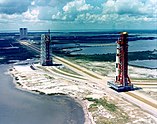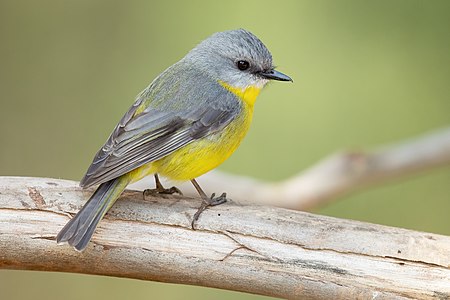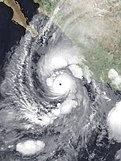Wikipedia:Main Page history/2022 July 29
From today's featured article

Apollo 4 was the first flight in the Apollo program and served as an initial uncrewed test of the Saturn V rocket. The first launch from Kennedy Space Center, Florida, where the space vehicle was assembled, it was originally planned to take place early in 1967 but was delayed to November 9 due to a myriad of issues. These included the need for additional inspections following the Apollo 1 fire that killed the first Apollo crew in January 1967. Apollo 4 was an "all-up" test, meaning that the spacecraft was fully functional on its initial flight, the first such for NASA. The Apollo 4 command module splashed down just under nine hours after its launch, having completed all objectives. NASA deemed the mission a complete success as it proved that the Saturn V rocket worked, which was important in achieving NASA's overall goal of landing astronauts on the Moon and bringing them back safely by the end of the 1960s. (Full article...)
Did you know ...
- ... that an inscription uncovered at the Pyramid of Khentkaus I (pictured), identifies Khentkaus I as the mother of two kings, or perhaps the mother of one and a king herself?
- ... that Canadian paediatrician Gladys Boyd was one of the first physicians to treat diabetic children with insulin?
- ... that Jerome Robbins's final ballet, Brandenburg, set to excerpts from Bach's Brandenburg Concertos, is likened to a kaleidoscope?
- ... that Athanasius Safar, a Syriac Catholic bishop from the Ottoman Empire, left Europe for Mexico in 1689?
- ... that following the ban of its labour unions in 1934, the Romanian United Socialist Party would rely on its youth and women's wings for political action?
- ... that the Clements twins have an estimated revenue of almost US$6000 per Instagram post?
- ... that the Japanese manga series Heart Gear sells three times better in France than in Japan?
- ... that the name of the Indian city Bangalore could be derived from a Kannada word meaning 'town of boiled beans'?
In the news
- In cycling, Jonas Vingegaard (pictured) wins the Tour de France.
- The World Health Organization declares the monkeypox outbreak a public health emergency of international concern.
- The Chinese paddlefish, one of the world's largest freshwater fish species, is declared extinct by the International Union for Conservation of Nature.
- Amid protests over the economic crisis, Ranil Wickremesinghe is elected President of Sri Lanka by the parliament.
On this day
- 1014 – Byzantine–Bulgarian wars: Byzantine forces defeated troops of the Bulgarian Empire at the Battle of Kleidion in the mountains of Belasica near present-day Klyuch.
- 1818 – French physicist Augustin-Jean Fresnel (pictured) submitted a memoir on the diffraction of light to the Royal Academy of Sciences, providing strong support for the wave theory of light.
- 1914 – The first shots of World War I were fired by the Austro-Hungarian river monitor SMS Bodrog on Serbian defences near Belgrade.
- 1954 – The first part of J. R. R. Tolkien's high-fantasy novel The Lord of the Rings was published by Allen & Unwin.
- Ivan Aivazovsky (b. 1817)
- Isabel, Princess Imperial of Brazil (b. 1846)
- Isidor Isaac Rabi (b. 1898)
From today's featured list
The 2018 Pacific hurricane season was an event in the annual cycle of tropical cyclone formation, in which tropical cyclones form in the eastern Pacific Ocean. The 2018 season officially started on May 15 in the eastern Pacific – east of 140°W – and began on June 1 in the central Pacific – the region between the International Date Line and 140°W, and ended on November 30. The season began with the formation of Tropical Depression One-E, which developed on May 10, and ended with the dissipation of the season's final storm, Tropical Storm Xavier, which dissipated as a tropical cyclone on November 5. The 2018 hurricane season was exceptionally active and featured the highest accumulated cyclone energy (ACE) since reliable records began in 1971. Throughout the season, 26 tropical depressions developed, 23 of which became tropical storms. A total of 13 tropical storms reached hurricane strength, and 10 hurricanes achieved major hurricane intensity. Activity peaked from early August to early October, with several long-lived and powerful hurricanes developing in that time period. Several storms severely affected land, such as Hurricane Lane in Hawaii and Hurricane Willa (pictured) in Mexico. (Full list...)
Today's featured picture

|
|
The eastern yellow robin (Eopsaltria australis) is an Australasian robin found in coastal and sub-coastal eastern Australia. The extent of the species's residence is from the extreme southeast corner of South Australia through most of Victoria and the western half of New South Wales and north as far as Cooktown. Birds in tropical northern Queensland are mainly restricted to the warm heights of the Great Dividing Range. This eastern yellow robin was photographed in Yengo National Park, New South Wales. Photograph credit: John Harrison
Recently featured:
|
Other areas of Wikipedia
- Community portal – The central hub for editors, with resources, links, tasks, and announcements.
- Village pump – Forum for discussions about Wikipedia itself, including policies and technical issues.
- Site news – Sources of news about Wikipedia and the broader Wikimedia movement.
- Teahouse – Ask basic questions about using or editing Wikipedia.
- Help desk – Ask questions about using or editing Wikipedia.
- Reference desk – Ask research questions about encyclopedic topics.
- Content portals – A unique way to navigate the encyclopedia.
Wikipedia's sister projects
Wikipedia is written by volunteer editors and hosted by the Wikimedia Foundation, a non-profit organization that also hosts a range of other volunteer projects:
-
Commons
Free media repository -
MediaWiki
Wiki software development -
Meta-Wiki
Wikimedia project coordination -
Wikibooks
Free textbooks and manuals -
Wikidata
Free knowledge base -
Wikinews
Free-content news -
Wikiquote
Collection of quotations -
Wikisource
Free-content library -
Wikispecies
Directory of species -
Wikiversity
Free learning tools -
Wikivoyage
Free travel guide -
Wiktionary
Dictionary and thesaurus
Wikipedia languages
This Wikipedia is written in English. Many other Wikipedias are available; some of the largest are listed below.
-
1,000,000+ articles
-
250,000+ articles
-
50,000+ articles




